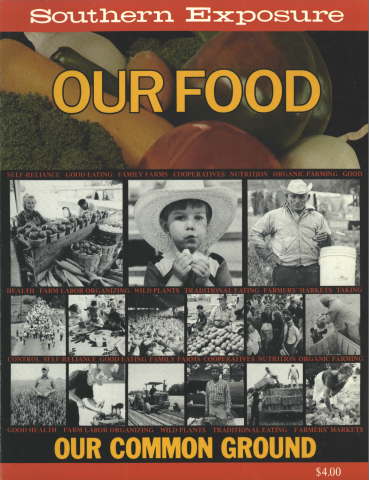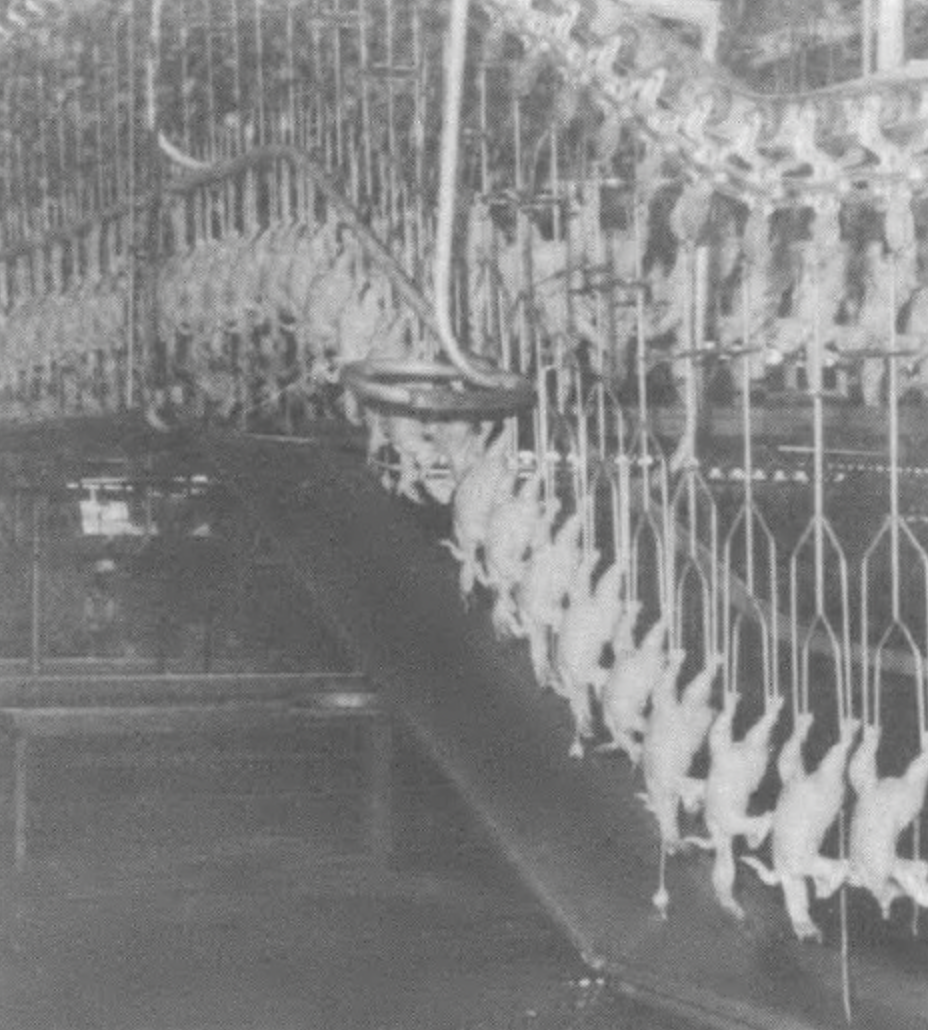
This article originally appeared in Southern Exposure Vol. 11 No. 6, "Our Food." Find more from that issue here.
EVERY PIECE OF POULTRY (OR other meat) we buy has its stamp of government approval, the little seal that tells us it has been inspected by the U.S. Department of Agriculture (USDA) and found fit to eat.
Those of us who remember our history lessons know we owe this service to Upton Sinclair, the muckraker whose expose of conditions in "The Jungle" - Chicago's packing houses led in 1906 to the first law mandating federal meat inspection.
What is less well-known is that the Reagan administration is quietly leading a return to the jungle that threatens the safety of meat consumers once more. In the slaughter houses, USDA employees inspect every animal by hand for disease or contamination — at least in theory. But the USDA is bowing to industry pressure to speed up the production lines, allowing vacant inspector positions to go unfilled, denying public access to information about plants in chronic violation of USDA regulations, and toying with various schemes to inspect only some of the slaughtered animals.
USDA reaction to industry pressure is no surprise when one considers who is making the decisions at USDA. Agriculture Secretary John Block is a hog farmer from Illinois. His official spokesperson for meat inspection policies is Assistant Secretary C.W. McMillan, who put in 22 years as executive vice president of the National Cattlemen’s Association, which fights regulations in an attempt to preserve the profitability of the declining red meat market. Also closely involved with the inspection program is Deputy Secretary Richard Lyng, who was president of the American Meat Institute from 1973 to 1979.
The law requires inspection of each carcass in a slaughter house. In the case of poultry, one inspector, with the aid of mirrors, views each side of two adjacent birds and then tells a plant employee where to trim it. Another inspector grabs each carcass, opens the abdominal cavity, and examines and handles the organs. All of that happens in less than two seconds. Inspectors have persistently complained that they cannot conduct adequate examinations at such high speeds, and many openly admit that present rates hinder their ability to spot contaminated meat.
An Alabama inspector wrote the department asking it to reconsider plans to speed things up even more: “Because the line is moving so fast, the inspector on the mirror may miss from one to five birds if he has to turn to give instructions to his trimmer. Even down the line, when he has only 35 chickens per minute, he doesn’t have time to properly inspect the chickens. Try to imagine in less than two seconds you must check the heart, kidneys, lungs, liver, spleen, muscles, sex organs, and look for contamination, plus give instructions to the trimmer and make sure they are carried out.
“Before you make any decisions on this, I think you should have chicken for dinner. While you are eating your chicken remember it was USDA INSPECTED AND PASSED. The inspector may have looked at well over 6,000 chickens without a break, maybe his eyes are getting tired. ... He may have turned to check on his trimmer and missed the bird you are eating. Which is more important, the businessman’s profits, or the fact that you may be eating that one chicken in a thousand that wasn’t inspected? The chicken may have . . . some liver disease, or maybe that lump you just ate was a tumor, maybe there was a little contamination inside the breast cavity, but who cares?
New practices also affect what happens when an inspector does spot trouble. Although the department denies it, several inspectors told me they are no longer authorized to slow down or stop the line without permission from the “inspector-in-charge.” Getting permission can take several minutes, during which the problem carcass speeds on down the line. Inspectors say this acts as a disincentive to carefully examine questionable carcasses.
“If you can’t control your line speeds,” says one inspector, “you can’t control the product.” As an example, he describes a recent day when he discovered many of the birds on his line had developed air sacculitis, a condition where the lungs fill up with a bacteria-laden, yellowish pus. The inspector says he “blew the buzzer” to alert his supervisor, but “it was 20 minutes before he got there and there was no way of catching up” with the carcasses.
In 1981 the Reagan administration began experiments with a variation on traditional inspection procedures that would allow plants to speed up the line to a rate of 85 birds a minute. An inspectors’ union local in Florida filed an unfair labor practice charge against USDA, alleging that the new methods would result in lower food quality and safety. And when the first test-run took place in a Pelahatchee, Mississippi, plant, the percentage of birds rejected as unfit for consumption fell to less than 1 percent — from the typical rate of 2.5 to 3 percent. Union officials suspect that contaminated birds were slipping by undetected.
Staff shortages are another serious problem, one that exacerbates the effects of the new procedures. Hiring and budget restrictions begun by the Carter administration left the Food Safety and Inspection Service (FSIS) short-handed — with 6 to 10 percent of inspection positions unfilled in 1980 — when Reagan was elected. Since then Congress has increased the FSIS budget by 5.1 percent, but USDA has refused to fill the vacancies. As of this October there were 345 inspector vacancies.
Slaughter inspectors, by law, must be on the kill floor continuously, but inspectors of processing plants are required only to visit each plant at least once a day. In many areas supervisors are pulling processing inspectors off their regular duties to help with slaughter inspections, and the processing plants are getting short shrift. One Florida inspector described his work this way: “It’s called the ‘Houston Shuffle’ [in honor of FSIS director Donald Houston], because you literally walk in [the plant], wave, turn around, and walk out .. . it’s a dangerous dance.”
Reginald Malone, a Miami inspector who has filed an unfair labor practice lawsuit over staff shortages, says he should cover only two or three plants during a normal work day, but now must travel to five or six.
Thanks to still other recent changes, information about unsafe conditions that FSIS does manage to uncover is not available to the public. Beginning in the early 1970s, the service began monitoring its inspection system by making surprise visits to plants and watching inspectors at work through its Program Review Branch. Between September, 1981, and January, 1982, these monitors checked conditions in 272 plants. They found adulterated or mislabeled meat in one-fifth of them and the “potential” for unhealthy products to slip past inspectors in about 71 percent. They considered it “likely” that rancid, substandard products were getting the USDA stamp of approval in 32 percent of the plants.
Shortly after the Kansas City Star published an expose based largely on Program Review Branch reports, the Reagan administration terminated public access to the reports and reorganized the branch into an impotent body with no enforcement capability.
A regulation issued by the Carter administration USDA, for example, required that chronic problem plants be publicly identified, and this became the branch’s most powerful enforcement tool. The Reagan administration USDA rescinded the regulation.
Reviewers now make announced visits to plants instead of surprise visits, and the number of routine visits was slashed in half in 1983. In place of plant-by-plant reports, reviewers now compose summaries of “minor” violations that do not name names. Plants with “serious” violations — a category that is undefined — still merit individual reports, but FSIS director Houston tried to exempt them from the Freedom of Information Act. Steve Goldschmidt, a reporter for Food Chemical News, sued for release of these documents and won in a federal appeals court. But FSIS still isn’t making it easy for the public to learn what’s in them.
The official rationale for all these changes is, of course, letting the free enterprise system take care of itself. The Reagan administration argues that the free market will prevent meat packers from violating health and safety standards. A consumer who gets sick from eating meat, so the argument goes, won’t buy that brand again. But several questions come to mind:
· Should the government willfully allow anyone to consume products inadequately examined for disease in an effort to prove an abstract theory about the invisible hand of the marketplace?
· If consumers get sick from eating contaminated chicken, how do they know where the meat originated — or even that diseased chicken was the part of the meal that made them sick?
· What of the obvious imperatives of the market? Producers and packers want to turn out as much meat as they can, as quickly as they can, even — in many cases — if this means including meat of questionable quality. Many producers will include as much as they can without risking a major scandal that will harm business. The government’s role is to ensure that as much of the meat as possible is safe for human consumption. Two distinct, often incompatible, goals — which is why there is friction between inspectors and industry, and why industry wants the government to leave it alone.
· If the free market can handle the matter of meat safety, why should the government bias consumer decisions by asserting that meat has been inspected by the government? If the government is no longer guaranteeing safety, it should not mislead consumers by stamping “USDA INSPECTED AND PASSED” on packages of meat and poultry. □
Tags
Kathleen Hughes
Kathleen Hughes is co-editor of Environmental Action magazine. This article is adapted from her report, Return to the Jungle: How the Reagan Administration is Imperiling the Nation ’s Meat and Poultry Inspection Program, published this year by the Center for Study of Responsive Law, where she was then a staff writer. Copies of the 63-page report are available from the Center for $6.50: P.O. Box 19367, Washington, D.C. 20036. (1983)

